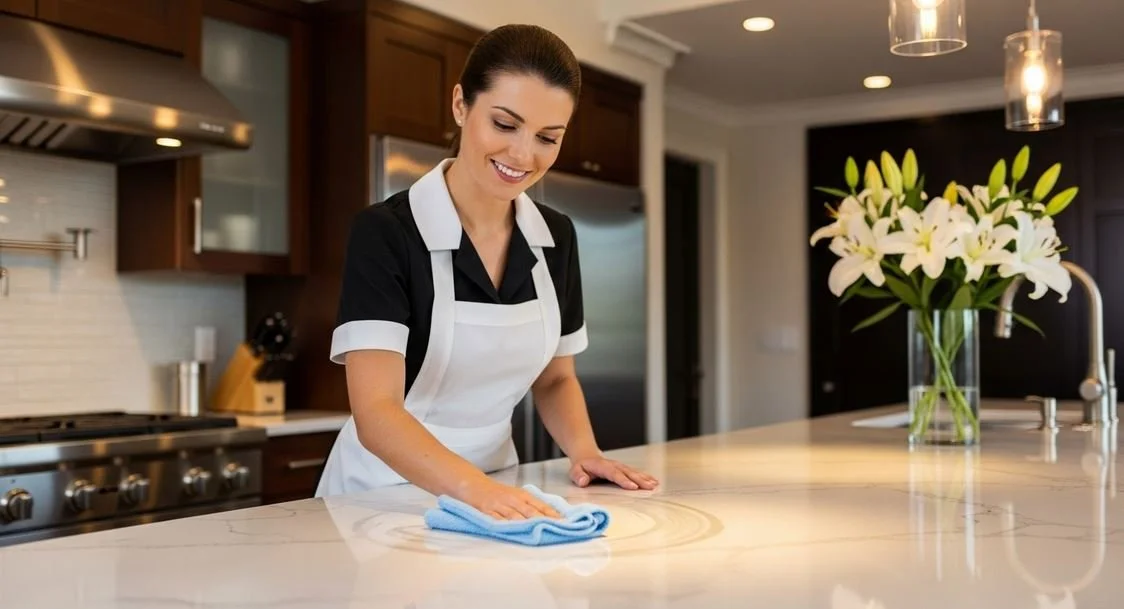Can You Use Bleach On Quartz? (No - Explained)
Quartz looks amazing anywhere from tables, vanities, countertops, tiles to décor pieces. It’s sleek, strong, and gives off that luxurious vibe that fits just about any space.
But when it comes to cleaning, a lot of people make one risky mistake: they grab the bleach.
Sure, bleach seems like the quick fix for stains and germs. It’s powerful, smells “clean,” and works wonders on a lot of surfaces, but just not for quartz.
In fact, using bleach can do the exact opposite of what you want.
In this post, I’ll explain why you should never use bleach on quartz surfaces.
Can I Use Bleach On Quartz?
Do not use bleach on quartz.
While quartz countertops are durable and can handle a fair amount of cleaning, bleach can actually cause some serious damage.
Bleach is a strong, harsh chemical, and quartz isn’t really built to handle that kind of abuse.
Quartz countertops are made from natural stone (like granite) combined with resin and other materials. This gives them their signature durability and aesthetic appeal, but it also makes them susceptible to some cleaning products.
Bleach is one of the worst offenders.
Also Read: Can You Mix Pine-Sol And Bleach?
What Happens If You Use Bleach On Quartz
Using bleach on quartz can lead to a few unwanted side effects. It won’t completely ruin your countertop right away, repeated use or even a single spill can cause permanent damage.
Here’s what can happen:
#1 Removes The Shine Or Gloss
One of the first signs of bleach damage is a dull surface.
Quartz usually has a beautiful, glossy finish that makes it stand out in any space. That shine comes from the resin coating, not the stone itself.
When bleach interacts with those resins, it starts to break them down. Slowly, that smooth finish fades, leaving behind a flat, chalky look instead of the reflective glow you’re used to.
The tricky part is that this doesn’t always happen instantly. Sometimes, the surface just looks “a little off” after cleaning, like the shine’s been muted.
But with repeated use, the damage builds.
Once the gloss layer is gone, there’s no easy way to bring it back without professional refinishing.
#2 White Or Cloudy Spots
Bleach can also leave behind strange white or cloudy patches that look like dried water stains.
These spots are caused by a chemical reaction between the bleach and the quartz’s resin binders. The bleach pulls color pigments out of the surface, leaving dull, uneven patches that never fully disappear.
You’ll notice this most clearly on decorative quartz items or flat surfaces like coffee tables and vanities. Even a small spill or splash can leave a mark if it sits for too long.
Over time, those cloudy spots make the surface look older and uneven - almost like it’s been sanded in some areas and polished in others.
Also Read: Is Fabuloso Safe For Pets?
Once that happens, the discoloration is usually permanent.
#3 Streaking Or Fading On Darker Quartz
Darker quartz surfaces like black, charcoal, or deep blue, are especially vulnerable to bleach.
The lighter streaks and faded lines it creates are much more noticeable. That’s because the pigment in dark quartz reacts more strongly with bleach, causing irregular color fading.
Instead of one clear mark, you might end up with streaks or blotchy lines that stretch across the surface.
It’s not just a visual thing either. The texture in those areas can also feel slightly rougher or more matte, especially if the bleach sat for a while before being wiped off.
It gives the quartz a patchy, uneven look that stands out under light, and unfortunately, it’s not something you can scrub away.
#4 Weakens The Sealant
Even if the surface looks fine after using bleach, it might not be as strong as it used to be.
Bleach weakens the sealant layer that protects quartz from spills and stains.
Once that barrier is compromised, everyday things like coffee, tea, makeup, or even cooking oil can start to seep into the surface, leaving stains that are much harder to remove.
Over time, you might notice your quartz doesn’t repel liquid the way it used to. Drops that once beaded up may now soak in slightly, or leave faint marks when they dry. This happens because the protective coating has been eaten away, leaving the quartz more exposed.
Also Read: Is CLR Septic Safe?
What To Do If You Spilled Bleach By Accident
Accidents happen. If bleach has touched your quartz, don’t panic - but act fast.
Wipe it off immediately using a soft, damp cloth. Then rinse the area thoroughly with water.
Repeat a few times to make sure all traces of bleach are gone. If you see a faint mark or discoloration, switch to a quartz-safe cleaner and gently go over the area.
Don’t scrub or apply pressure as that’ll only make the damage worse.
If the spot has already faded or feels rough to the touch, it’s best to call a professional quartz restorer. They might be able to polish or refinish the area, depending on the level of damage.
But honestly, catching it early is always the best move.
Safe Ways To Clean Quartz Surfaces
The good news? Keeping quartz clean doesn’t take much. You don’t need harsh chemicals or heavy-duty disinfectants. Gentle, simple cleaners work better and help preserve that beautiful finish.
Here are two easy, safe ways to clean any quartz surface:
Mild Dish Soap + Warm Water
This is all you really need for everyday cleaning.
Mix a little dish soap with warm water, dip a soft cloth or sponge in it, and wipe the surface. It cuts through grease, dirt, and grime easily.
Once you’re done, rinse it with clean water and dry it with a microfiber cloth.
That quick wipe-down keeps quartz looking shiny and spotless without any risk of damage.
70% Isopropyl Alcohol + Water
If you want to disinfect your quartz safely (maybe after prepping food or just for a deep clean) this mix is perfect.
Combine equal parts isopropyl alcohol and water in a spray bottle. Mist the surface lightly, wait a few seconds, and wipe it clean with a soft cloth. It sanitizes without breaking down the resin or leaving streaks behind.
If you prefer store-bought options, just look for products labeled quartz-safe or pH-neutral.
Avoid anything that says “degreaser,” “acidic,” or “strong cleaner.” Those often contain harsh chemicals that can damage the quartz over time.
Bottom Line
Do not use bleach on quartz. It can strip away shine, fade color, and even weaken the protective layer that keeps the surface looking perfect.
Stick with gentle cleaners like dish soap or an alcohol-water mix.
They’ll keep your quartz sparkling and smooth for years without risk. Quartz is durable, not indestructible, and a little care goes a long way.
So the next time you reach for that bottle of bleach, set it aside and grab something gentler.

